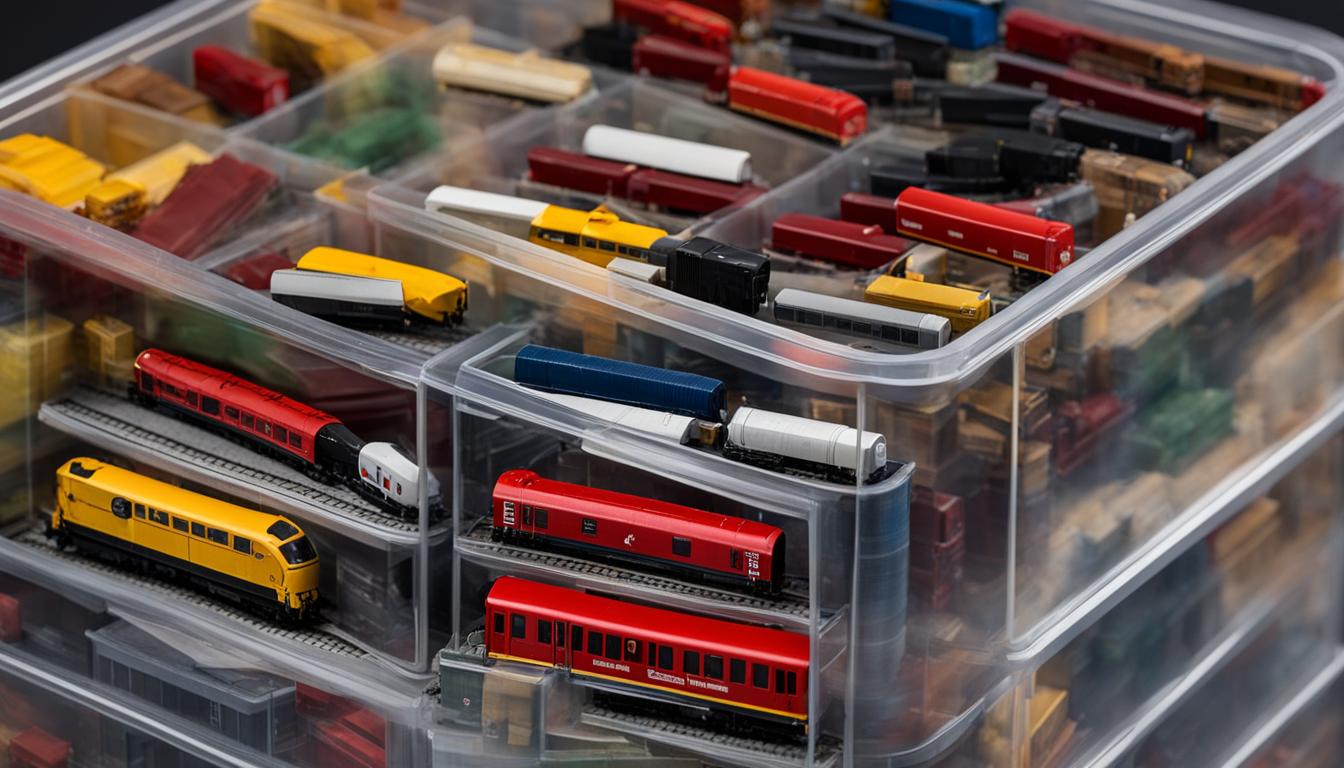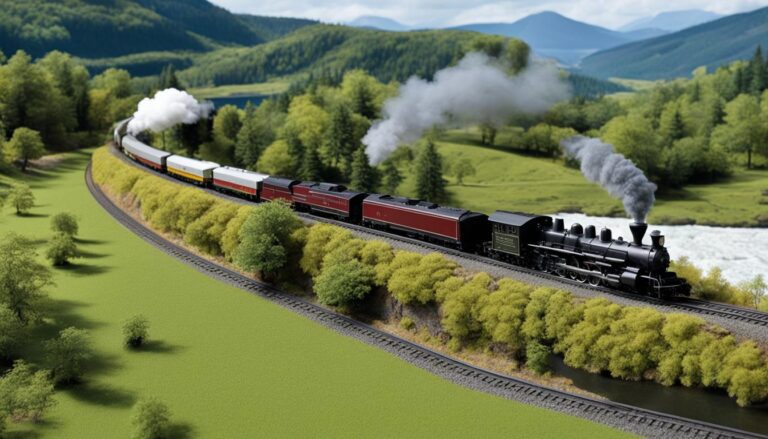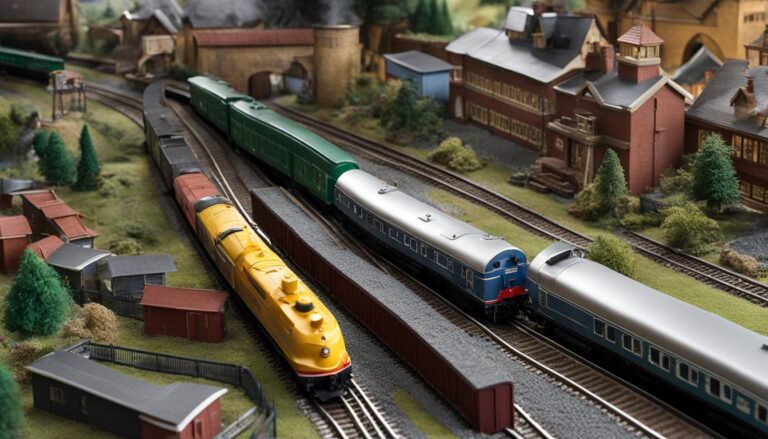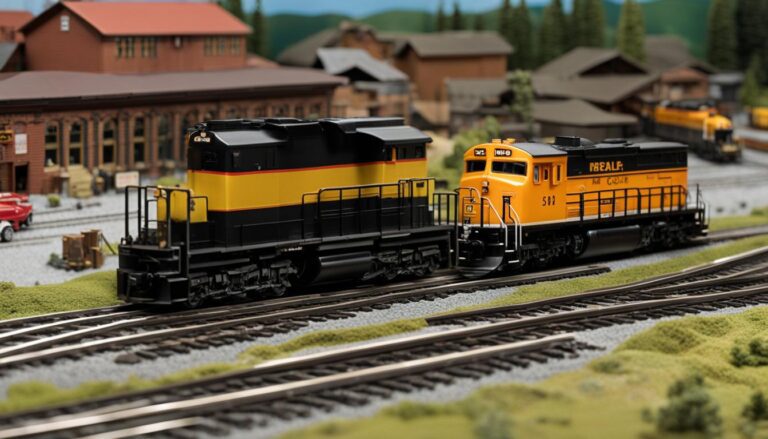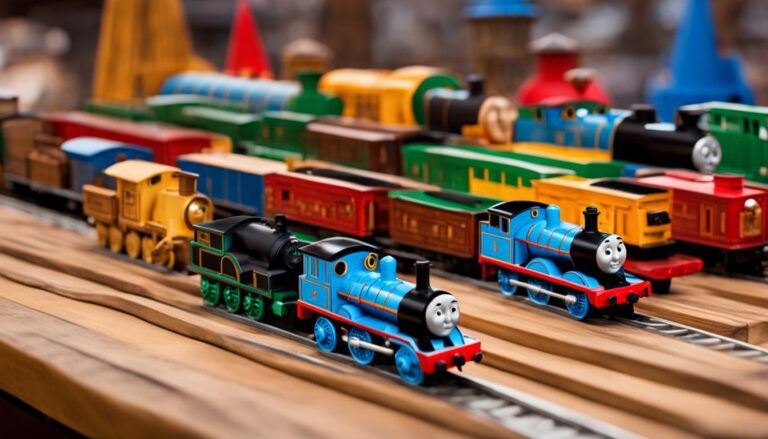How to Store Model Trains – Your Ultimate Organization Guide
Is your collection getting old and jumbled? Don’t worry—I have some useful tips on how to store things that will turn your problem into a well-organized paradise. Let’s get started and learn the best ways to keep your beloved model trains in fantastic shape.
Key Takeaways:
- Picking the right storage bins is important to keep your model trains safe.
- Protect delicate parts and decals from damage by wrapping them in acid-free tissue paper.
- Be careful when you handle your trains, and pay special attention to safe parts like the locomotive or rolling stock.
- Keep your trains out of direct sunlight, florescent lights, damp places, and places where the temperature and humidity change.
- Setting up the right conditions is important for long-term storage.
The Importance of Proper Storage for Model Trains
Proper storage is very important if you want to keep and protect your expensive collection of model trains. Properly storing model trains not only protects them from damage caused by dust, wetness, and changes in temperature, but also makes sure they last for a long time. By following these important tips on how to store model trains, you can keep your collection in good shape and keep its value for years to come.
One of the most important reasons to store model trains properly is to keep dust and other things from piling up. Over time, dust can build up on the trains’ delicate surfaces, leaving lines that look bad and could even cause damage if they aren’t cleaned properly. Keeping the trains in a clean, dust-free space, like sealed storage cases, makes it less likely that dust will settle on the models.
Minimize Moisture
In addition to dust, wetness is another important thing that can hurt model trains. Mold, rusting, and rust can all happen when there is too much humidity, all of which are very bad for the trains. Protect your collection from water damage by keeping it in a dry place away from places where water leaks or there is a lot of humidity.
“Proper storage of model trains is not just about keeping them organized; it’s about preserving a piece of history and ensuring their longevity.”
| Factors | Importance |
|---|---|
| Dust and Debris | Prevents marks and potential damage |
| Moisture | Prevents corrosion, rust, and mold growth |
| Temperature Fluctuations | Prevents warping and damage to delicate components |
Changes in temperature can also be bad for model trains. Extreme heat or cold can bend fragile parts in ways that can’t be fixed. To keep your collection from getting damaged in this way, it is important to keep it in a place with stable temperature. Do not put the trains near windows, vents, or other places that will get direct sunshine or temperature changes.
Model trains need more than just the right way to be stored; you have to be dedicated to keeping these important pieces of history safe. Realizing how important it is to store your model trains correctly and following the tips given will help your collection stay in great shape and bring joy to future generations.
Choosing the Right Containers to Store Model Trains
When you need to store model trains, having the right bins can make all the difference. Choosing the right containers is important for keeping your valuable collection safe and in good condition, whether you have the original packing or need to find something else.
If you’re lucky enough to still have the original packaging for your model trains, that’s the best way to store them. The makers of these crates make them to protect the trains while they are being moved or stored. The models are snugly packed in their original packing, which often has foam inserts that keep them in place and stop them from moving or breaking.
Do not worry, though, if you cannot find the original package! You can still find bins that are good for storing your model trains. Another option is to use plastic storage cases. Look for containers that are strong and have lids that fit tightly to keep dust and water out. Make sure the bins are big enough to fit all of your trains without being too crowded.
You could also use wooden boxes. Pick boxes that are clean, strong, and big enough for your models to fit inside without any problems. You might want to use tape to strengthen the sides to make them more stable. Make sure the boxes are clearly labeled so you can see what’s inside without having to open each one.
The Bottom Line
To sum up, picking the right storage containers for your model trains is very important, whether you still have the original boxes or need to find new ones. The best way to protect something is in its original package, but plastic storage containers or cardboard boxes can also work. The bins should be clean, safe, and have enough room for your trains. You can keep your model trains safe and in good shape for years to come by choosing the right storage bins.
Table: Comparison of Containers to Store Model Trains Options
| Storage Container Option | Advantages | Disadvantages |
|---|---|---|
| Original Packaging | – Designed specifically for model trains – Provides a snug fit – Often includes foam inserts for added protection | – Limited availability if original packaging is lost – May not accommodate larger or custom models |
| Plastic Storage Containers | – Secure lids to keep out dust and moisture – Durable and reusable – Available in various sizes | – May not provide a snug fit for irregularly shaped models – Some containers may have sharp edges that could potentially damage the trains |
| Cardboard Boxes | – Cost-effective option – Easy to find and label – Can be customized with additional padding if needed | – Less durable compared to plastic containers – Susceptible to damage from moisture or pests if not properly stored |
Each type of storage case has its own pros and cons, which can be seen in the table. When picking the best containers for storage, think about your needs and the state of your model trains.
Protecting Delicate Parts and Decals
When you store model trains, you need to be extra careful to keep the decals and delicate parts that are easily broken safe. If you don’t handle and store these parts correctly, they can easily get broken. To make sure they last a long time, use these helpful tips:
Wrap with Acid-Free Tissue Paper
Putting delicate parts and decals in acid-free tissue paper is one of the best ways to keep them safe. This special paper keeps dust and moisture from getting to the models, keeping them in perfect condition. Carefully cover all the sensitive parts of each model train with tissue paper as you wrap it up.
Secure with Rubber Bands When You Store Model Trains
The tissue-wrapped models should be held in place with rubber bands so they don’t move and cause damage. This helps keep the parts in place so they don’t scratch or rub against each other while they’re being stored.
Use Individual Boxes To Store Model Trains
There is an extra layer of safety you could add by putting each wrapped model train in its own box. This makes it even less likely that something will get broken by mistake and adds another level of organization.
| Protective Strategy | Advantages |
|---|---|
| Acid-Free Tissue Paper | – Shields against moisture and dust – Preserves delicate parts and decals |
| Rubber Bands | – Prevents rubbing and scratching – Keeps components in place |
| Individual Boxes | – Offers additional protection – Organizes the collection |
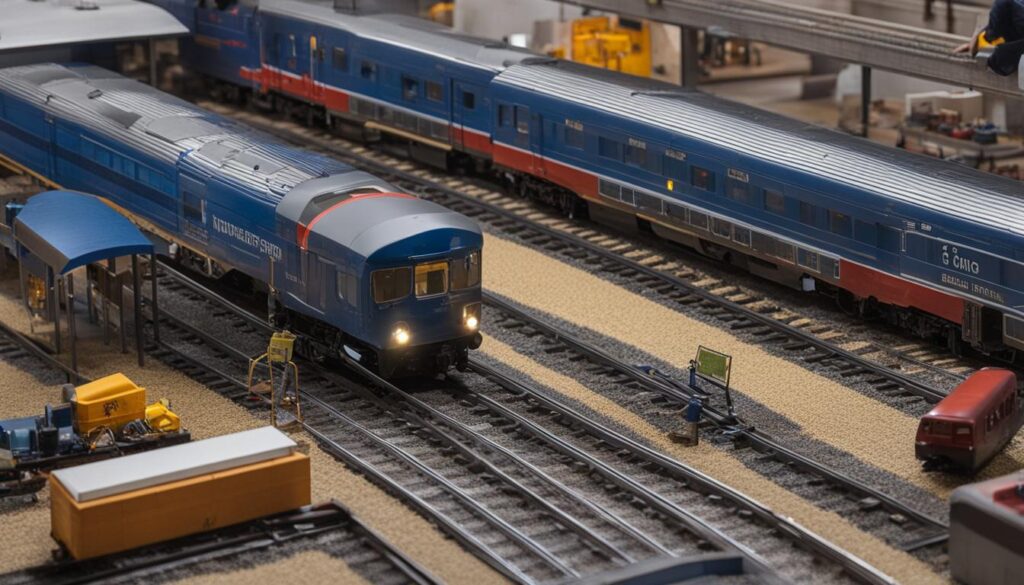

If you follow these tips, you can keep your model trains safe and keep their stickers and parts from getting broken. Your collection will stay beautiful and valuable for years to come if you store it properly and keep it safe.
How to Handle and Store Model Trains Correctly
If you want to keep your beloved model trains in good shape, you need to know how to handle and store them correctly. Here are some tips from experts to keep your trains in great shape:
Handle with Care
Remember to be gentle when you’re handling your model trains and not use too much force or pressure. Always hold them by the parts that are secure, like the rolling stock or the locomotive, so they don’t get broken by mistake. If you are careful with your trains, they won’t get scratched, broken, or damaged in any other way.
Protect with Cushioning
To keep your model trains safe from bumps and vibrations while they’re being stored, it’s important to give them the right padding. You might want to put something safe around your trains, like Styrofoam or bubble wrap. This will help absorb any shocks and keep you from moving around too much, which could hurt you. Rubber bands can be used to hold loose parts in place while they are being moved or stored.
Create an Ideal Storage Environment
Your model trains should be kept in a safe place where they can’t get hurt. Keep them out of strong sunlight and fluorescent lighting, which can fade or change the color of them over time. You should also avoid storing your trains in places with a lot of humidity or big changes in temperature, as these can hurt their health. Keeping your trains in a stable and controlled climate will help them last longer and be of higher quality.
By employing these effective techniques for handling and storing model trains, you can ensure the longevity and beauty of your collection for years to come.
Keeping Model Trains in a Suitable Environment
When it comes to storing model trains, it’s not just about finding the right containers or handling them with care. The environment in which you store your trains plays a significant role in their long-term preservation. To ensure the utmost protection for your valuable collection, it’s important to keep the trains away from direct sunlight and fluorescent lighting. These sources of light can cause fading and discoloration over time, diminishing the aesthetic appeal of your models.
Also, it’s important not to store your trains in places with a lot of humidity or big changes in temperature. Too much water can cause mold to grow and damage fragile parts, and big changes in temperature can crack or bend things. If you want to keep things stable, you might want to keep your model trains in a room or cabinet with temperature control.
By taking these precautions and keeping your model trains in a suitable environment, you can ensure their longevity and pristine condition. Remember, protecting your collection from direct sunlight, avoiding fluorescent lighting, and maintaining consistent humidity and temperature levels are key factors in preserving the value and beauty of your model trains for years to come.
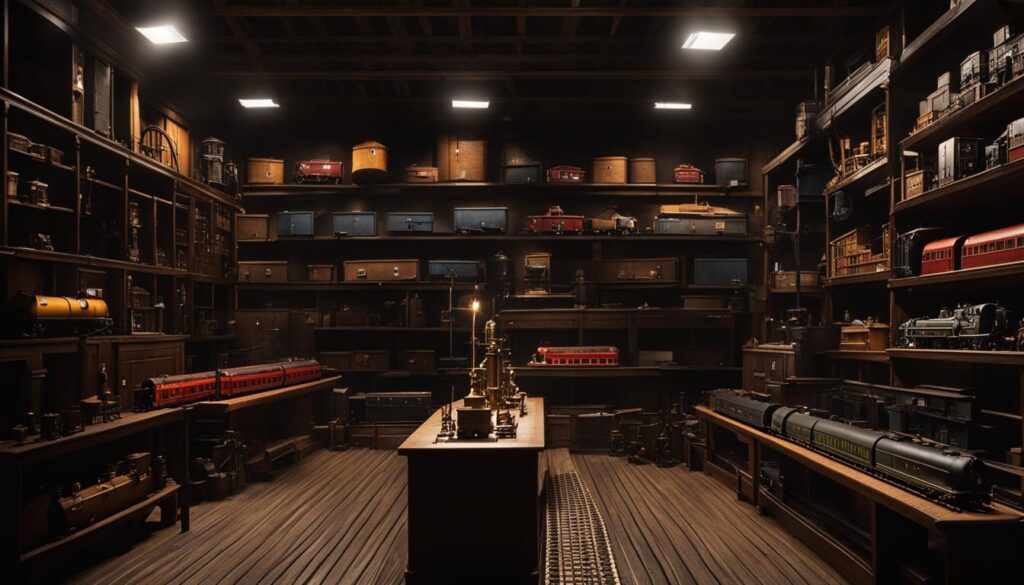

Tips for Storing Model Trains in the Right Environment:
- Avoid placing your trains near windows or in areas exposed to direct sunlight.
- Choose a location with stable temperature and humidity levels, away from heaters, vents, or areas prone to moisture.
- Consider investing in a dehumidifier or using moisture-absorbing products to regulate humidity levels.
- Utilize blinds or curtains to block out sunlight when necessary.
- Use proper insulation and sealing to minimize temperature fluctuations.
By implementing these measures, you can create an ideal environment for your model trains, ensuring their preservation and enjoyment for generations to come.
Conclusion
Well, that’s a wrap! Now you’re equipped with the best practices for storing your model trains. With these tips, you’ll be able to keep your collection organized and protected for years to come.
Remember, when it comes to model train storage, it’s crucial to choose the right storage containers. Whether you opt for the original packaging or sturdy cardboard boxes, make sure they’re clean and provide ample space for your trains.
Handling your model trains with care is also essential. Always hold them by secure parts like the rolling stock or locomotive, and use cushioning materials like styrofoam or bubble wrap to prevent any damage during storage.
Lastly, create a suitable environment for your trains by keeping them away from direct sunlight, fluorescent lighting, and extreme humidity or temperature fluctuations. By following these model train storage solutions, your collection will remain in top condition, ready to be admired or even expanded upon at any time.
FAQ
Can I use plastic storage containers or cardboard boxes to store model trains?
Yes, plastic storage containers or sturdy cardboard boxes can be used as long as they are clean, dust-free, and provide enough space to prevent any damage to the trains during storage.
How can I protect delicate parts and decals when storing model trains?
Use acid-free tissue paper to wrap the models and prevent any moisture or dust from reaching them. Secure the tissue paper with rubber bands or gently place the models inside individual boxes to avoid any rubbing or scratching.
How should I handle and store model trains to prevent damage?
When handling the trains, make sure to hold them by the secure parts such as the rolling stock or the locomotive. Use styrofoam or bubble wrap to provide cushioning and prevent any impact or vibration during storage. Secure loose parts with rubber bands to avoid any movement that could cause damage.
What kind of environment should model trains be stored in?
Model trains should be kept away from direct sunlight and fluorescent lighting to prevent fading or discoloration. Avoid storing them in areas with high humidity or extreme temperature fluctuations, as these conditions can damage the models over time.

